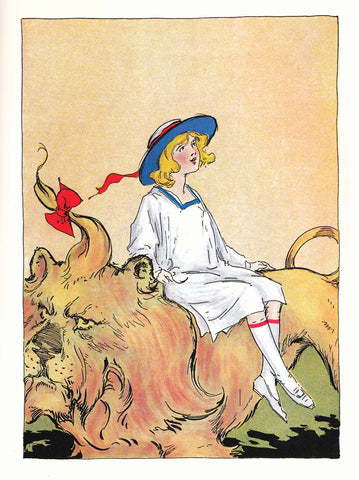 VISIT
MUSEUM STORE
MEMBERSHIP
OZ NEWS
CONTACT
VISIT
MUSEUM STORE
MEMBERSHIP
OZ NEWS
CONTACT
EV’RYBODY REJOICE! (AND HOPE FOR THE BEST….) – Part Two
Wamego#44
April 17, 2015 EV’RYBODY REJOICE! (AND HOPE FOR THE BEST….) – Part Two



[Above left: The original Broadway cast of THE WIZ in a 1975 publicity photo: Hinton Battle as the Scarecrow, Stephanie Mills as Dorothy, Ted Ross as the Cowardly Lion, and Tiger Haynes as the “Tinman.” Center: The fifteen year old Miss Mills was extolled in his first-night review by Howard Kissel of WOMEN’S WEAR DAILY: “I must confess that I fell in love with [her] from the moment she stepped on stage. Her eyes are filled with wonder and sometimes seem brimming with tears, and her voice is just sensational. When she moves into her upper register, it’s quite enough to send you over the rainbow.” Right: The inside cover of the original souvenir program for THE WIZ, celebrating the seven Antoinette Perry “Tony” Awards it won -- just fifteen weeks after its debut on Broadway.]
------
THE WIZ – like most Broadway productions of the modern age – had an early opening night curtain. After forty years, I now can’t recall the precise hour, though I would imagine the show began at six, six-thirty, or seven p.m. By 1975, we also were well into the era when the various critics (whether television, radio, or daily or weekly press) were given the option of attending a preview performance, usually across two or three days just prior to the official premiere. All their opinions were “held” until the hours or day(s) immediately following the latter, but the greater leeway gave any scribe more time to consider and prepare an evaluation.
Thanks to the very welcome pushing, prodding, and long-distance patrol of The International Wizard of Oz Club’s executive secretary, Fred M. Meyer, I was there at New York’s Majestic Theatre on THE WIZ’s official opening night, Sunday, January 5, 1975 -- sent and assigned to critique it myself for the thrice-annual Club publication, THE BAUM BUGLE. At that moment in Broadway history, the most expensive orchestra and front mezzanine spots for a musical topped off at $15.00. My location was at the opposite end of the price spectrum, and I think the ticket cost all of $6.00; it entitled me to be way upstairs (and grateful for the privilege, I hasten to add) in one of very last rows of the sixteen-hundred-plus Majestic seats. As noted in last week’s entry, however, THE WIZ had come to town with very little advance sale or wide-spread, positive word-of-mouth, and there were empty spaces around and below me – even on this occasion of its gala launch. As a result, and just prior to the Kansas “Prologue,” I was able to move down into one of the side seats in the first dozen rows of the balcony.
My recollection is that I took only very brief notes throughout act one, preferring instead to scribble down any salient impressions during intermission. I did the same thing, referencing act two, when I got home that evening, and the subsequent Fricke assessment appeared in the Spring 1975 issue of the BUGLE. I can do no better here than to recap that vintage journalism; I re-read it in preparation for this blog, and it seemed to say everything I would want to share -- especially as the expressed impact therein was fresh and very much of its time. (It’s also “of” my more-limited journalism experience, as well as the obligation I felt to be both as stringently honest and Ozzily hyper as my reactions would allow!)
Anyway, here it is:
-----
After two years of planning and two months on the road, THE WIZ – the all-black musical version of L. Frank Baum’s THE WONDERFUL WIZARD OF OZ – opened at New York’s Majestic Theatre…. Though not for die-hard purists, [THE WIZ] is nearly always agreeable and sometimes highly entertaining.
Producer Ken Harper has mounted a fairly faithful adaptation of the first Oz book, laced with clever, “one-liner” humor, never-ending camp, and an extraordinary sense of style. He has made the most of the opportunities inherent in an all-black production. The major flaw in this treatment, however, is that the lavish Cotton Club musical numbers leave little room for more than sketchy outlines of character and motivation. As a result, the William F. Brown script often has only the depth of a Flip Wilson “Geraldine” routine, and during such potentially moving scenes as the Wizard’s presentation of gifts to Dorothy’s companions, the audience is left unmoved. It is difficult to sympathize with caricatures. In addition, the humor sags badly in the second act.
Much of the glow of THE WIZ must be attributed to director Geoffrey Holder, who replaced road-show director Gilbert Moses III. [Holder] keeps things moving quickly which, considering the nature of the production, is undoubtedly wise. The gorgeous harem of poppies (later Glinda’s attendants), the Field “Mice Squad,” the singing and dancing Yellow Brick Road, and the crows are all excellent examples of his stylized staging. Holder’s eye for sparkle extends to the physical as well; his costumes are alternately beautiful or outrageous but always appropriate and colorful.
George Faison’s rousing choreography hits a soulistic peak with “Funky Monkeys,” but his most impressive effect is achieved earlier with the ingenious and imaginative “Tornado Ballet.” The dances and costumes are well complimented by Tom H. John’s settings and effects.
THE WIZ touches nearly every musical base, from the hard-driving beat of SHAFT to rock/pop versions of typical Broadway ballads. Act Two provides a series of numbers that could well stand out from the context of the show. Particularly notable are the upbeat “No Bad News” and “Everybody Rejoice” and the somewhat quieter “Believe in Yourself” and “Home.” Act One offers more songs immediately related to the story, with “He’s the Wiz”/”Ease on Down the Road” (read “We’re Off to See the Wizard”/”Follow the Yellow Brick Road”), and the signature songs for the Scarecrow, Tin Woodman, and Cowardly Lion: “I Was Born on the Day Before Yesterday,” “Slide Some Oil to Me,” and “Mean Old Lion.” Charlie Smalls, who wrote both the music and lyrics for THE WIZ, provides one of the evening’s finest moments when Dorothy comforts her cowardly companion with the ballad “Be A Lion.” Her understanding of his fears [as expressed] in this song is an excellent evocation of Baum’s original little girl from Kansas. Harold Wheeler’s orchestrations of the score are brilliant and well-conducted by Charles H. Coleman. Unfortunately, Mr. Coleman did only part of his job well; his vocal arrangements – as is frequent with today’s pop music – start strongly but then terminate abruptly without the “build” necessary for a show-stopping song.
The principal performers are unceasingly energetic, and the audience cannot help sharing their enthusiasm. Stephanie Mills as Dorothy is, as the Cowardly Lion puts it, a true “Little Mama.” Publicity states that she is fifteen-years-old; at any age, she would be an extraordinary singer and an adequate (though not particularly graceful) dancer. She does not, however, have much charismatic appeal except when she is singing. Top-billed Tiger Haynes, who plays the Tin Woodman, is a musical comedy veteran, and it shows in his shuffling tap routine and talent to amuse, although he has less to do than the actors playing the Scarecrow and the Cowardly Lion. Eighteen-year-old Hinton Battle, who replaced television comic Stu Gilliam as the Scarecrow while the show was on the road, is a fine and amazingly limber dancer; Ted Ross is consistently entertaining as the prospective King of the Forest.
Fine contributions are also made by Clarice Taylor, Mabel King, and Dee Dee Bridgewater as, respectively, Addaperle (the Good Witch of the North), Evillene (the Wicked Witch of the West), and Glinda. Miss Taylor is happily scatter-brained and effectively ineffectual when she sends Dorothy down the Yellow Brick Road. Miss King has a boisterous, gravel-throated solo, “(Don’t Nobody Bring Me) No Bad News,” that is the most rousing Act Two opening in memory. Miss Bridgewater has the show’s smoothest voice and the most sultry personality. Andre De Shields plays the Wiz as a cross between a glittery rock star and Aimee Semple McPherson. His Act Two departure from the Emerald City is written as a huge revival meeting, a good idea that the script does not quite bring off, despite his power-packed delivery.
All the principals have individual body microphones. The sound system is distracting, and the soloists occasionally have to combat not only the powerful orchestra but four pit singers as well. Lyrics are discernible perhaps seventy-five percent of the time.
Amidst the brouhaha, THE WIZ retains several Baum touches. Dorothy and her companions are outfitted with green glasses on their first (but not their second) entrance into the Emerald City. The country’s overall color scheme is followed to a limited extent (the wardrobe for Glinda and her attendants is predominantly red, and that for the Munchkins is blue). The Kalidahs, however, look like giant beans with legs, and Toto only appears onstage prior to the cyclone and at the very end of the show.
THE WIZ is not a particularly innovative musical, but it has imagination, energy, color, enthusiasm, a highly serviceable score, and so far as humor is concerned, a passable book. It provides an entertaining evening, with much of the entertainment drawn from the fact that the theme and story are already familiar and much-loved.
-----
Well, I was only twenty-four….
(And it shows!)
Yet I stand by virtually everything I said, with the exception of the first statement in the last paragraph. THE WIZ was, indeed, an innovative musical, and Maurice Peterson -- then the omniscient commentator for ESSENCE -- summarized the historical situation at hand with much more savvy than I could manifest: “In THE WIZ, something grand has, in effect, been born: a golden age for black musical theater.” Subsequent decades of Broadway, regional, and international vehicles unconditionally have underscored his thesis – much to the delight of countless world-wide audiences during these past forty years.
But….
What of THE WIZ, once its opening night curtain fell? What would the critics say later that night on TV and radio? What kind of reviews would the newspapers and weekly magazines provide across the next hours or days? Would there be enough good (and good will) among their comments to propel the show into a run on Broadway…or even a second week of performances? Those who read Part One of this mini-series about THE WIZ may remember that the producers – with little money in the till -- had posted the presentation’s closing notice, effective at the conclusion of that gala first night.
Any who know their WIZ-tory should be able to supply generic answers to some (if not all) of those questions. But across the reality of January 5th into January 6th, 1975 – and immediately beyond – no one knew if THE WIZ would prevail…or triumph…or fold its yards and yards of cyclone cloth and immediately shut down.
[to be concluded]
Article by John Fricke



